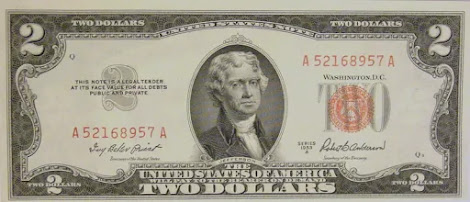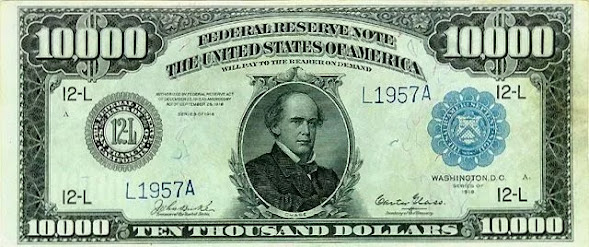Rare Currencies
The first $2 bills were printed in 1776—nine days before the United States became an independent nation. They originally featured a portrait of Alexander Hamilton but were later redesigned to portray Thomas Jefferson. Aesthetically, the $2 bill is something to behold. The reverse side features a reproduction of one of the most famous paintings in American history—"Declaration of Independence" by John Trumbull.
Excluding the decade from 1966 to 1976, $2 bills were printed uninterruptedly since the Civil War.2 Yet the average American who doesn't handle cash for a living can go years without seeing one. While the $2 note is still in circulation and the Bureau of Engraving and Printing recognizes it as legal tender—it is considered to be the rarest currency denomination in the U.S.1 There were still 1.3 billion notes in circulation in 2019.
The Treasury minted several versions of the $500 bill, featuring a portrait of President William McKinley on the front. The last $500 bill rolled off the presses in 1945, and it was formally discontinued 24 years later in 1969.
Like all the bills featured here, the $500 bill remains legal tender.
Most $500 notes in circulation today are in the hands of dealers and
collectors. That being said, should you come into possession of a $500
bill, you'd find that its market value far exceeds its face value, with even worn specimens commanding upward of a 40% premium on the open market.
The original $1,000 bill featured Alexander Hamilton on the front. When someone presumably realized that it might be confusing to have the same former Secretary of the Treasury on multiple denominations, Hamilton was replaced with that of another president—the 22nd and the 24th, Grover Cleveland.
Like its smaller cousin, the $500 bill, the $1,000 bill was discontinued in 1969. And like the $500 bill, the $1,000 bill would seem to have a lot more use now than it did then.
Why? Inflation, of course. The Consumer Price Index (CPI) was at an estimated 36.8 back in 1969. As of December 2019, U.S. CPI sat at over 256, meaning a $1,000 bill today would be the equivalent of a only $153 bill during the Summer of Love.
The Treasury argues that keeping the denominations inconveniently small minimizes the possibility of money laundering.That being said, hold onto a $1,000 bill that finds its way into your palm even more tightly than you would a $500 bill. There are only 165,372 of these bills bearing Cleveland's visage still in existence.
The $5,000 bill was initially issued to finance the Revolutionary War and was only officially printed by the government when the Civil War began.
The bill was graced with a portrait of James Madison. President Richard Nixon ordered that the bills be recalled in 1969 due to fear of criminals using them for money laundering activities.
The value of a $5,000 bill is many times its face value. Fewer than 400 of these notes are believed to exist.
Salmon P. Chase -a virtual unknown from history- was a governor and senator from Ohio, who never served as president. He did serve as Secretary of the Treasury under Abraham Lincoln and became chief justice of the Supreme Court, Chase is on the $10,000 bill.
This is the largest denomination ever printed for public consumption, but the $10,000 bill never got much use. This lack of use is understandable, given that its value outstripped the net worth of the average American during the time the bill was available.
First printed in 1918 it was part of the 1969 purge of large currencies. Like its $5,000 counterpart, only a few hundred authenticated samples survive.
Featuring a portrait of Woodrow Wilson, the $100,000 note was actually a gold certificate that was never circulated or issued for public use. The Bureau of Engraving and Printing created them during the Great Depression in 1934, for conducting official transactions between Federal Reserve banks.
Only 42,000 of the $100,000 bills were ever printed.
While the $100,000 bill can not be legally held by collectors, however, some institutions like the Museum of American Finance display them for educational purposes.
The Smithsonian Museum and some branches of the Federal Reserve System (FRS) also have these extremely rare bills in their possession.
Sources:
https://www.investopedia.com/6-famous-discontinued-and-uncommon-u-s-currency-denominations-4773302









Comments
Post a Comment